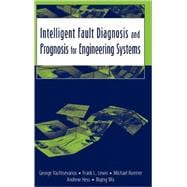
What is included with this book?
Frank L. Lewis, Phd, is Head of the Advanced Controls, Sensors, and MEMS Group in the Automation and Robotics Research Institute at The University of Texas at Arlington, in Fort Worth, Texas.
Michael Roemer, Phd, is Director of Engineering at Impact Technologies, LLC, in Rochester, New York.
Andrew Hess is Air System PHM Lead and Development Manager in the Joint Strike Fighter Program Office at Naval Air Systems Command, in Patuxent River, Maryland.
Biqing Wu, Phd, works on various topics of active disturbance control and CBM/PHM. She is currently serving as a research engineer at the Georgia Institute of Technology, in Atlanta, Georgia.
| PREFACE | xi | ||||
| ACKNOWLEDGMENTS | xiii | ||||
| PROLOGUE | xv | ||||
| 1 INTRODUCTION | 1 | (12) | |||
|
1 | (2) | |||
|
3 | (1) | |||
|
4 | (1) | |||
|
5 | (2) | |||
|
7 | (5) | |||
|
12 | (1) | |||
| 2 SYSTEMS APPROACH TO CBM/PHM | 13 | (43) | |||
|
13 | (3) | |||
|
16 | (2) | |||
|
18 | (8) | |||
|
26 | (2) | |||
|
28 | (9) | |||
|
37 | (12) | |||
|
49 | (5) | |||
|
54 | (2) | |||
| 3 SENSORS AND SENSING STRATEGIES | 56 | (39) | |||
|
56 | (1) | |||
|
57 | (20) | |||
|
77 | (3) | |||
|
80 | (9) | |||
|
89 | (2) | |||
|
91 | (4) | |||
| 4 SIGNAL PROCESSING AND DATABASE MANAGEMENT SYSTEMS | 95 | (77) | |||
|
95 | (1) | |||
|
96 | (1) | |||
|
97 | (7) | |||
|
104 | (24) | |||
|
128 | (18) | |||
|
146 | (4) | |||
|
150 | (2) | |||
|
152 | (10) | |||
|
162 | (1) | |||
|
163 | (2) | |||
|
165 | (7) | |||
| 5 FAULT DIAGNOSIS | 172 | (112) | |||
|
172 | (3) | |||
|
175 | (6) | |||
|
181 | (10) | |||
|
191 | (20) | |||
|
211 | (16) | |||
|
227 | (8) | |||
|
235 | (8) | |||
|
243 | (15) | |||
|
258 | (9) | |||
|
267 | (4) | |||
|
271 | (8) | |||
|
279 | (5) | |||
| 6 FAULT PROGNOSIS | 284 | (71) | |||
|
284 | (5) | |||
|
289 | (12) | |||
|
301 | (11) | |||
|
312 | (21) | |||
|
333 | (18) | |||
|
351 | (4) | |||
| 7 FAULT DIAGNOSIS AND PROGNOSIS PERFORMANCE METRICS | 355 | (45) | |||
|
355 | (1) | |||
|
356 | (2) | |||
|
358 | (4) | |||
|
362 | (23) | |||
|
385 | (10) | |||
|
395 | (1) | |||
|
396 | (2) | |||
|
398 | (2) | |||
| 8 LOGISTICS: SUPPORT OF THE SYSTEM IN OPERATION | 400 | (17) | |||
|
400 | (1) | |||
|
401 | (3) | |||
|
404 | (1) | |||
|
405 | (4) | |||
|
409 | (1) | |||
|
410 | (6) | |||
|
416 | (1) | |||
| APPENDIX | 417 | (7) | |||
| INDEX | 424 |
The New copy of this book will include any supplemental materials advertised. Please check the title of the book to determine if it should include any access cards, study guides, lab manuals, CDs, etc.
The Used, Rental and eBook copies of this book are not guaranteed to include any supplemental materials. Typically, only the book itself is included. This is true even if the title states it includes any access cards, study guides, lab manuals, CDs, etc.